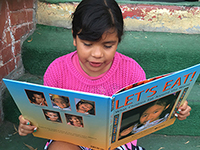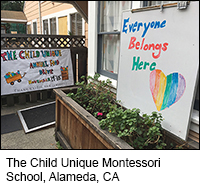 One of my favorite lessons for lower elementary students is The Fundamental Needs of Humans. It is designed to help children understand that people everywhere have the same basic needs even though those needs are fulfilled in different ways by various cultures. This worldview is at the core of Montessori philosophy and cosmic education – encouraging peace, understanding, and respect for people all over the world.
One of my favorite lessons for lower elementary students is The Fundamental Needs of Humans. It is designed to help children understand that people everywhere have the same basic needs even though those needs are fulfilled in different ways by various cultures. This worldview is at the core of Montessori philosophy and cosmic education – encouraging peace, understanding, and respect for people all over the world.
Material and Spiritual Needs
Maria Montessori wrote that peoples’ fundamental needs fall into two categories: material (survival needs) and spiritual (pertaining to the soul and intellect). In order to realize a more peaceful world, she considered spiritual needs to be of utmost importance.
Material needs include:
- shelter
- food
- clothing
- transportation
- defense (safety, protection)
- communication
Spiritual needs include:
- love
- spirituality/religion
- culture/arts/music
- vanitos (self-adornment)
The Fundamental Needs of Humans
Present this lesson after The Story of the Coming of Humans. Some teachers take their class outdoors to a park or quiet corner of the playground. Others invite children to imagine they are on a desert island. Be creative; make this lesson your own.
Children, please sit down under this magnificent old oak tree. I have a very special lesson for you today…
Pretend that we have gone back in time, long before your grandparents and great grandparents were born. Long, long ago. Imagine that you are one of the early humans. What would you need to survive? What are the fundamental needs of humans? I’ll write down all of your ideas.
Encourage the children to brainstorm. Record everything without comment. Children usually mention food, and shelter. Ask questions to help them discover other material needs. What about wild animals? How will we protect ourselves?
Now let’s go through this list and discuss which items are absolutely necessary. For example, could humans survive without TV?
Help children begin to understand the term “spiritual needs.” You may need to ask leading questions to generate ideas. Once material needs are taken care of, humans also have spiritual needs. Do we need love? Beauty?
After the children have brainstormed and discussed their list, present the chart, Fundamental Needs of Humans. Under the two main categories (material and spiritual), every need is listed, accompanied by small illustrations. Discuss a few of the needs, perhaps marveling at how different houses look in other parts of the world, although each satisfies the need for shelter. Vanitos features pictures of a mirror, comb and necklace. Point out that people all over the world adorn themselves in various ways, such as with jewelry, face paint and head dresses. Children often point to Religion, sharing which symbols of the major religions they recognize and asking about the ones that aren’t familiar.
Follow-Up Work
Encourage students to do research about what intrigues them. They can make posters using photographs cut from magazines to illustrate how a particular need is fulfilled in different countries. One year some of my students were fascinated by houses from around the world and built replicas of a Navajo hogan, a junk, and a house on stilts.
Children can also make international foods, listen to world music, experiment with art from different cultures, or play instruments from around the world.
Older Students
Upper elementary students can research how civilizations, from ancient to modern times, fulfilled their fundamental needs. What happened to civilizations that couldn’t fulfill their needs? How difficult is it today for some people to find clean water or enough food? This research constitutes a foundation for social studies, leading to the study of economic geography.
Teachers can encourage more reflection about the spiritual needs of humans. You might ask older students to discuss Mario Montessori’s statement that music was born to answer the need of humans to “portray the majesty of higher feelings, touched with the perfume of the sacred.” Ask children what helps them to be in touch with their spirit and their feelings of love and joy.
Connecting and Caring
 Like in Montessori’s time, there are many challenging issues today related to the fundamental needs of children, families, and all of humanity. Teachers, students, and parents can all play an important role in creating caring and peaceful communities in our schools, where the need for safety is met and everyone feels welcome.
Like in Montessori’s time, there are many challenging issues today related to the fundamental needs of children, families, and all of humanity. Teachers, students, and parents can all play an important role in creating caring and peaceful communities in our schools, where the need for safety is met and everyone feels welcome.
The realization that all humans, across the ages and continents, share the same needs, can help to connect us, no matter what language we speak, or what religion we honor. Cosmic education, with its great stories and lessons, including The Fundamental Needs of Humans, helps create understanding and respect, the foundation for a peaceful world.
At the Mesa Verde Museum
In the glass case
is a necklace
with 5,000 stone beads
all drilled and strung
over a thousand years ago
and I think of the man
whose hands did the work –
how he chose not just
to survive, but to make
something beautiful…
—Rosemerry Wahtola Trommer
 Montessori blog Montessori blog
Montessori blog Montessori blog 